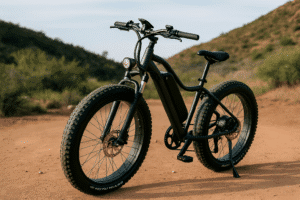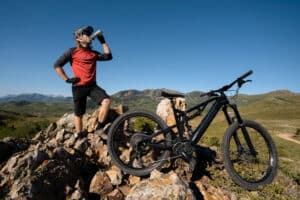E-bikes are changing how many of us explore the outdoors—but are they actually allowed in national forests? The answer isn’t as simple as yes or no.
Rules vary depending on the trail, your e-bike type, and even which forest you’re in. I’ve done the digging so you don’t have to.
Here’s everything you should know before heading into the woods with your e-bike.
TL;DR
Electric bikes are allowed in national forests, but only on roads and trails where motorized vehicles are already permitted. Most non-motorized trails are off-limits unless specifically approved for e-bike use. Class 1 e-bikes have the best chance of being allowed on more trails, especially in states like California and Colorado.
Rules vary by forest, so always check local trail maps or ask a ranger before riding. National parks follow slightly different rules, generally allowing e-bikes wherever regular bikes are allowed.
E-Bike Classification: Know Your Ride
Before you can figure out where you can ride, you need to know what kind of e-bike you have. Not all electric bikes are treated the same on public lands. The U.S. Forest Service groups e-bikes into three different classes—and the rules can change depending on which class you’re riding.
Here’s a quick breakdown:
- Class 1: Pedal-assist only. The motor helps only when you’re pedaling, and it stops helping at 20 mph. These are the most commonly accepted e-bikes on shared-use paths.
- Class 2: Throttle-assist. You can ride without pedaling, but it still cuts off at 20 mph. These often get lumped in with other motorized vehicles.
- Class 3: Pedal-assist up to 28 mph. Faster, and usually not allowed on non-motorized trails due to speed concerns.
If you’re unsure which class your e-bike falls under, check your manufacturer’s info. It’s often listed on a label near the crank or battery.
Are Electric Bikes Allowed in National Forests?
Yes, electric bikes are allowed in national forests—but only on trails and roads where motorized vehicles are permitted.
That means if a trail is already open to dirt bikes, ATVs, or cars, you can usually ride your e-bike there too. But if it’s a trail marked “non-motorized,” like one reserved for hikers or traditional mountain bikes, then your e-bike is generally off-limits—unless that trail has been specifically approved for e-bike use.
This can feel confusing, and honestly, it kind of is. Some national forests have started opening more trails to Class 1 e-bikes, especially those that see heavy recreational use.
But many are still playing it safe and keeping e-bikes off quieter paths to reduce trail damage and avoid spooking hikers or wildlife.
The key takeaway? Don’t assume you can ride your e-bike everywhere a regular bike can go. Always double-check the local rules before you head out.
Current U.S. Forest Service Policy on E-Bikes
The U.S. Forest Service treats electric bikes as motorized vehicles. That might sound strict, but it’s actually pretty standard when it comes to public land management. The idea is to manage e-bikes similarly to motorcycles and ATVs—especially since they’re powered in part by a motor, even if they feel more like bicycles.
Here’s what’s new: in 2022, the Forest Service finalized updated guidance for e-bike use. The big change? Local land managers now have more freedom to decide where e-bikes can go. That means certain trails that were previously off-limits could eventually open up to e-bikes—especially Class 1 models.
The Forest Service didn’t remove the “motorized” label, but it did introduce a few tools to help local teams evaluate new trail options. They now consider how emerging technologies like e-bikes are changing outdoor access, and there’s a clearer path to designating “e-bike only” trails.
I like that they’re leaving room for change. It shows they’re paying attention to how people actually want to use these public lands. Still, don’t expect a full green light on every trail just yet.
National Forest Rules vs. National Parks: What’s the Difference?
National forests and national parks follow different rules when it comes to e-bikes. In general, national parks are more uniform and often allow e-bikes wherever traditional bikes are permitted, while national forests take a case-by-case approach depending on local trail designation.
Let me break it down a bit more:
National Parks (Managed by the National Park Service)
- E-bikes are usually treated just like traditional bikes.
- If a path is open to bicycles, it’s likely open to e-bikes too (usually Class 1 and 2).
- There’s less variation from one park to another.
National Forests (Managed by the U.S. Forest Service)
- E-bikes are considered motorized vehicles.
- Allowed only on roads and trails open to motorized use—unless the local ranger district makes a special exception.
- Local land managers have more say, which means rules can vary even within the same state.
Why the Difference?
The agencies have different goals. National Parks are all about preservation and controlled recreation. National Forests balance recreation with logging, grazing, and more—so there’s more flexibility, but also more complexity.
Long story short: Don’t assume that if you can ride your e-bike in a national park, you can do the same in a national forest. Check the map, talk to a ranger, and be prepared for different answers depending on where you are.
Where Can You Legally Ride Your E-Bike in National Forests?

E-bikes are legal on national forest trails and roads that are already open to motorized vehicles—like forest service roads, OHV (off-highway vehicle) trails, and some multi-use paths.
That means if a dirt bike or ATV is allowed on a trail, your e-bike probably is too. But the moment a trail is marked “non-motorized,” it’s usually off-limits—unless that specific trail has been approved for e-bike use by the local forest service team.
I always recommend checking with a ranger station or the forest’s website before heading out, especially if you’re planning to ride on singletrack or backcountry routes.
Some resorts and special-use areas within national forests also allow e-bikes inside their permitted boundaries, but that doesn’t carry over to the surrounding public trails. It’s all about local rules, and they can change from one trail to the next.
Why Are There Restrictions?
E-bikes can ride faster and carry more weight than traditional bikes, which brings up a few concerns on shared or sensitive trails.
Here’s why e-bike access is sometimes limited:
- Trail wear and tear: Heavier bikes and higher speeds can cause more ruts, especially on soft dirt or narrow paths.
- Safety: E-bikes can surprise hikers or horseback riders on blind corners or crowded trails.
- Wildlife: Quieter doesn’t always mean gentler—fast-moving bikes can still disrupt animals and nesting spots.
- Trail sharing conflicts: Not everyone loves being passed by a motorized bike on a peaceful nature trail.
Examples of States or Forests with Notable Policies
Some states are taking a more open-minded approach to e-bikes—California is a good example. Many national forests there, like the Los Padres and Tahoe National Forests, are now experimenting with Class 1 e-bike access on select non-motorized trails.
These changes didn’t happen overnight—local groups pushed for the updates, and the Forest Service ran pilot programs to study the effects.
Colorado is another state making progress. In places like White River National Forest, some Class 1 e-bikes are allowed on popular trails that were previously off-limits. The state has embraced e-bikes on public lands and continues to adjust based on feedback and research.
Utah’s also worth mentioning. Areas like Moab have become e-bike hotspots, and while many trails are still closed to them, you’ll find certain routes specifically designated for Class 1 use. It’s a growing trend there, especially with tourism in mind.
On the flip side, forests in parts of Oregon and Washington have been slower to adapt. In some regions, e-bikes are still treated the same as dirt bikes and limited to designated motorized trails only. Local advocacy is strong, though, and change may come over time.
Tips for Riding Your E-Bike in a National Forest
Want to stay legal and avoid drama on the trail? Follow these simple tips:
- Check before you go – Visit the forest’s website or stop by a ranger station to confirm trail access.
- Stick to the rules – If a trail isn’t marked for motorized use, don’t assume your e-bike is allowed.
- Be polite – Yield to hikers and horses, and keep your speed in check, especially on busy trails.
- Don’t cut corners – Literally. Stay on the trail and avoid riding through brush or creating your own path.
- Pack it in, pack it out – Respect the land and leave it how you found it. No one likes trash on a trail.
Final Words
So, are electric bikes allowed in national forests? Yes—but only on certain roads and trails where motorized vehicles are already permitted. If the trail is labeled “non-motorized,” your e-bike is off-limits unless a local exception has been made.
Here’s the simple version: know your e-bike class, double-check the trail rules, and stick to areas where e-bikes are clearly allowed.
Class 1 models tend to have the most access, especially in states like California and Colorado, but things can vary a lot depending on where you’re riding.
I’d say this—riding your e-bike through national forests can be an amazing experience. Just take the time to do a bit of research first.
A quick check online or a chat with a local ranger can save you a headache and help you enjoy your ride with peace of mind.
FAQs
Are e-bikes allowed in all national forests?
Not all of them. It depends on the forest and the specific trail. E-bikes are generally allowed on motorized trails, but non-motorized trails usually remain off-limits unless officially opened up by the local ranger district.
Can I ride a Class 2 or 3 e-bike on hiking trails?
Usually not. Most non-motorized hiking and biking trails don’t allow Class 2 or Class 3 e-bikes. Some areas may allow Class 1 bikes, but always check local rules before heading out.
How do I know if a trail is motorized or non-motorized?
Look at the trail map or signage at the trailhead. You can also find this info on the national forest’s website or by calling a ranger station. If in doubt, don’t ride until you’re sure.
Are permits required?
Sometimes. Some areas may require a permit, especially for motorized trails or OHV routes. It varies by forest, so it’s best to check in advance.
Can I ride an e-bike in national parks too?
Yes, but with limits. E-bikes are generally allowed anywhere traditional bikes are permitted, but not on hiking-only trails. Each park may have slightly different rules, so check with the specific park you’re visiting.
Michael Josh is a hands-on e-bike tester and reviewer at BoltBikers, known for putting every model through real-world rides before sharing his thoughts. With a sharp eye for performance, comfort, and build quality, he helps the team choose which bikes are worth featuring. Backed by years of experience in tech and gear reviews, Michael brings trusted, honest insights to help readers find the right e-bike for their needs.








